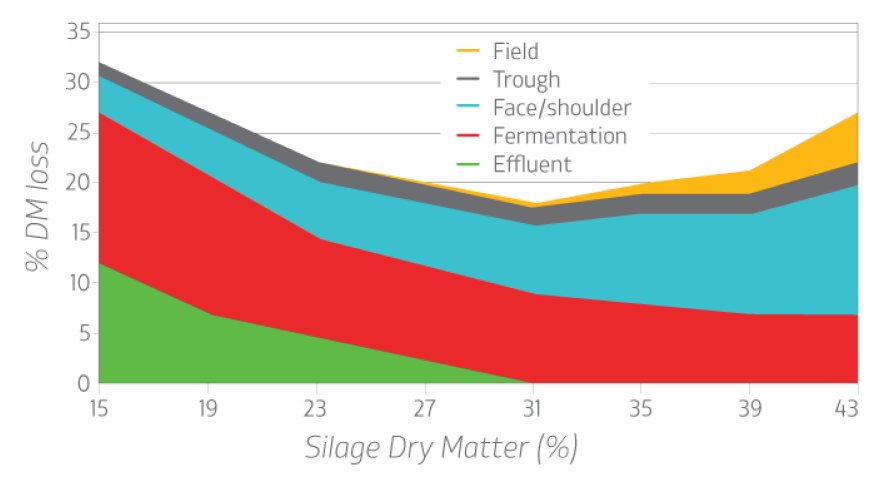What losses occur when making and feeding grass silage?
The total losses that occur in silage arise from a number of sources – the relative importance of which depends on the crop dry matter (DM)
In wet crops, effluent losses are important. Invisible losses also occur during the fermentation process itself, although the more efficient the fermentation, the lower these losses will be. With higher %DM crops, risks from aerobic spoilage (heating) increase, due to difficulties consolidating drier material in the clamp, and these losses can be very high, particularly at feed-out.
Even in a very well-made silage, typical DM losses will be between 8 - 10%, or possibly more. But if attention to detail slips, losses could easily be over 30%, while silage that has undergone significant aerobic deterioration can result in total losses above 50%. As much of these losses are in the form of carbon dioxide, they are often not noticed.
Examples of possible dry matter losses in silage
|
Range (%) |
|
|
Field |
2-10 |
|
Fermentation |
10-15 |
|
Effluent |
0-5 |
|
Aerobic spoilage |
10-30 |
|
Total |
20-50 |
Examples of losses at different percentage (%) dry matters (well-managed system)

In Germany, Honig was able to relate dry matter losses to temperature increase for crops of different %DMs. He found that with a 30% DM crop there was a 0.23% loss in DM per day for every 1°C increase in temperature above ambient.
Based on this, for a 30% DM silage the following losses can be calculated:
DM losses (%) calculated using 0.23% DM loss/day/oC heating - Honig (1986)
|
oC |
Time (days) |
||
|
3 |
5 |
7 |
|
|
5 |
3 |
6 |
8 |
|
10 |
7 |
12 |
16 |
|
15 |
10 |
17 |
24 |
What factors will help achieve a good grass silage fermentation?
- A clean sward – free from contamination from soil, slurry and other contaminants
- Adequate sugar in the crop for the fermentation
- Targeting a DM of 30% will give the best balance to achieve clamp stability and good DM intakes. DMs may be a little higher for young leafy ‘multi-cut’ type crops
- Appropriate chop length – drier, stemmy material requires a shorter chop to achieve a good compaction to remove air and create anaerobic (oxygen-free) conditions
- Rapid clamp filling – ideally clamps should also be sheeted every night (if filling is going to take longer than two days, this is essential)
- Sufficient compaction – the drier the material the more important the rolling and sealing to exclude air
- Application of a proven bacterial additive (inoculant) which applies high numbers of specially-selected, efficient lactic acid-producing bacteria
Does feeding grass silage cause acidosis?
The optimum pH value for the rumen is pH 6.2. If conditions become too acid (i.e. the pH falls too low) the fibre-digesting bacteria and protozoa will start dying off. This results in reduced digestibility and intake, so the cow takes in less nutrients – leading to poor body condition and fertility and other health disorders e.g. laminitis.
To prevent the rumen pH value from altering significantly, the cow produces copious amounts of saliva (150 litres/day). If the cow did not produce saliva, eating silage could (in theory) reduce the pH value to below pH 3.
However, it is not just the pH value of the silage that is important, but also the buffering capacity (Bc). The Bc of a silage is a measure of how much saliva the cow will need to produce to maintain the rumen at pH 6.2 if it eats that silage. Bc is only partly dependent on pH value as a lot of other compounds contribute to the total Bc – e.g. proteins.
It is therefore possible to have two silages with the same pH value but quite different Bc values. Indeed, if two silages have identical pH values, the silage with the higher proportion of lactic acid to other volatile fatty acids (higher LA:VFA ratio) will usually have a lower Bc and it will be easier for the rumen to maintain the optimum pH value.
Many of the acidosis problems blamed on feeding low pH value silages are in fact the result of feeding the wrong supplements alongside the silage, e.g. a readily-fermentable carbohydrate that will cause rapid acid production in the rumen so making matters worse.
What grass silage characteristics influence intake?
Intake is influenced by many factors including % dry matter (DM), chop length, digestibility and fermentation quality. High %DM, high digestibility and short chop length increase intake.
Many intake predictions are based on fermentation parameters such as pH value, fermentation acids and ammonia but it is well known that such predictions often do not tie in well with animal performance.